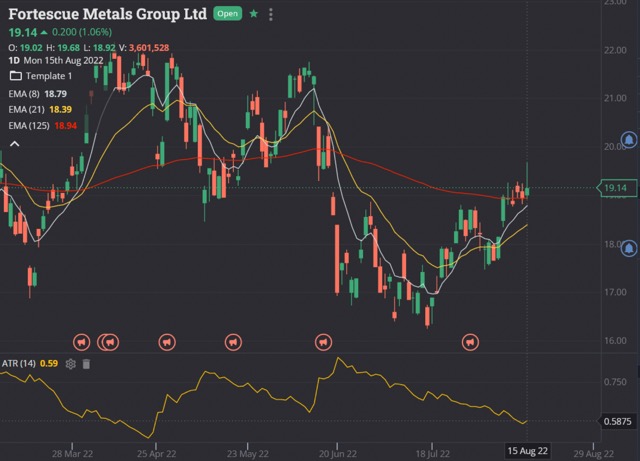How to protect your gains with stop-losses

许多交易者预计市场将再次下跌。
With the market having now recovered more than half of its losses, it’s timely to remember how little has actually changed.
Many of the same people worried another down-leg in the market was coming are now starting to fear that they have been left behind.
Which can be a bad sign in itself!
And there is still inflation. There are still high petrol prices. There are still major issues in supply chains and there is still a war in the Ukraine.
The market has rallied strongly, even when people were busily selling off at the bottom, comparing it to the GFC and 1987 crashes, and mapping chart comparisons out foretelling another leg lower.
How to protect yourself
Now that it has recovered, a lot, it is probably worth looking at how to protect yourself.
It’s not certain that these negative theories will come true, but it is certain that there will be more sell-offs in the future, and so it is important to have a plan – especially in smaller capitalisation companies.
So that we don’t annoy any of the smaller companies, for this exercise we will use Fortescue Metals Group (ASX: FMG) – as it is big enough to handle a few retail stop-loss orders!
It is also important to remember that technical analysis will not work as well with smaller companies as their volumes are often lighter, and they are often event-driven – more than herd- or trend-driven ones.
But Fortescue often fluctuates as much as a small-cap stock, so it’s a perfect example.
There are a number of indicators of a ‘top’ formation, but no individual sign is sufficient. Sometimes the RSI overshoots, sometimes an intra-day candle will show sellers taking back over, and as we discussed previously sometimes the moving average cross works too.
Volatility indicator for stop-losses
But in this article, we’ll discuss stop-losses and the volatility indicator that may help you position your stop-loss orders – the Average True Range (ATR).
The problem with stop-losses is that the market is naturally volatile. And the more volatile it is, the bumpier the ride, so you don’t want to get knocked out too easily – to then find that the stock rebounds quickly.
I once heard someone refer to it as “playing with a yo-yo while walking up (or down!) stairs”, and that made some sense.
The ATR does not provide an indication of price trend, it just calculates the degree of price volatility.
So the lower the volatility, the lower the ATR, and the tighter your stop-loss should be. The higher it is, and the reverse is true.

Fortescue Metals chart. (Marketech)
In the above chart, you will notice that volatility peaked at the lows (panic) and bottomed at the highs (malaise?).
More importantly, it shows that you should have a tighter stop when people aren’t panicked, because markets tend to go up if all else is equal.
People are naturally optimistic and looking for a return on their money, but can panic easily.
Double the ATR value
The conventional wisdom when using the ATR is that you should set your stop-loss at double the ATR value.
So as at this Fortescue chart (15 August 2022), your stop-loss should be:
58.75c x 2 = $1.175 below the last price. Which means around $18.57.
Low enough that you won’t get knocked out by day-to-day fluctuations, but close enough to protect you in a more severe sell-off.
Other factors to consider
According to Marketech Online Trading managing director Travis Clark when using stop-losses there are a few more factors to consider.
“When people are using stop-losses, there is a ‘trigger price’, and an ‘order price’. The trigger places the order, so in this case, you might put your trigger at $18.57.”
“But if you place your order at $18.57 as well, you may miss the market, especially if it reopens significantly lower after a bad day on the offshore markets,” Mr Clark explained.
“The market may jump your order, gap down, and you’ll be stuck in the queue.”
He said the company recommends that people consider setting the order price a little lower in case it drops quickly, and establish an ‘alert’ at the same price as the trigger, so your phone will ping if the stock gets to your stop-loss price and you can quickly jump in and amend it if necessary.
“We set the platform up for these exact scenarios, so if you have a look at the image I’ve supplied, you can see the green line is the cost base at $19.14, the trigger at $18.57 with the blue dotted alert line at the same price, and the order at $18.19.”
“When the trigger hits, so will an alert, then I can check the order quickly on my phone to make sure it all went well. And if not, I can just click the line on the chart and drag it down to amend it,” Mr Clark noted.

Fortescue Metals chart with stop-loss. (Marketech)
“There are a couple of other things about stop-loss orders that people need to remember. Once the order is triggered it will still need to be checked for any potential breaches to market rules, so don’t put the order in too much lower than the trigger or it will get blocked, and if you put the stock for sale in the market higher, the stop-loss trigger will not cancel that higher order so the automated order router will think you don’t have stock to sell.
One of the only limitations of offering $5 minimum trades is that Marketech traders have to have stock on their HIN to sell and cash to buy, so it would not go into the market – perhaps use a trigger-sell above the price for taking profits too, so it will either trigger-sell you out higher, or lower – whichever happens first.
And please don’t use them in thinly traded stocks!“
